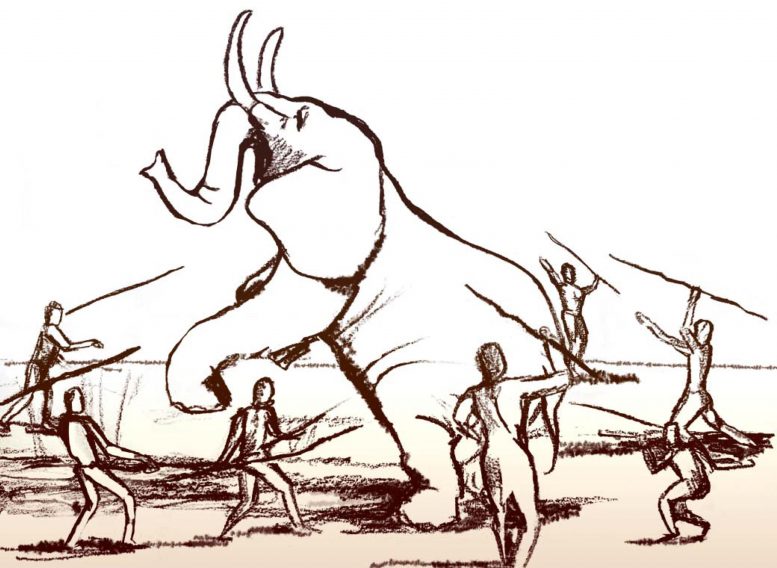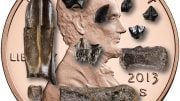A new paper by Dr. Miki Ben-Dor and Prof. Ran Barkai from the Jacob M. Alkow Department of Archaeology at Tel Aviv University proposes an original unifying explanation for the physiological, behavioral, and cultural evolution of the human species, from its first appearance about two million years ago, to the agricultural revolution (around 10,000 BCE). According to the paper, humans developed as hunters of large animals, causing their ultimate extinction. As they adapted to hunting small, swift prey animals, humans developed higher cognitive abilities, evidenced by the most obvious evolutionary change — the growth of brain volume from 650cc (0.6 liters) to 1,500cc (1.5 liters). To date, no unifying explanation has been proposed for the major phenomena in human prehistory. The novel theory was published in Quaternary Journal.
In recent years more and more evidence has been accumulated to the effect that humans were a major factor in the extinction of large animals, and consequently had to adapt to hunting smaller game, first in Africa and later in all other parts of the world. In Africa, 2.6 million years ago, when humans first emerged, the average size of land mammals was close to 500kg (1,100lb). Just before the advent of agriculture, this figure had decreased by over 90% — down to several tens of kg.
According to the researchers, the decrease in the size of game and the need to hunt small, swift animals forced humans to display cunning and boldness — an evolutionary process that demanded increased volume of the human brain and later led to the development of language enabling the exchange of information about where prey could be found. The theory claims that all means served one end: body energy conservation.
The researchers show that, throughout most of their evolution, early humans were apex (top) predators, specializing in hunting large game. Representing most of the biomass available for hunting, these animals provided humans with high fat levels, an essential source of energy, and enabled a higher energy return than small game. In the past, six different species of elephants lived in Africa, comprising more than half of the biomass of all herbivores hunted by humans. Initial evidence from East Africa indicates that homo sapiens only emerged in that area after a significant decline in the number of elephant species in certain regions. Comparing the size of animals found in archaeological cultures, representing different species of humans in East Africa, southern Europe, and Israel, the researchers found that in all cases there was a significant decline in the prevalence of animals weighing over 200kg (440lb), coupled with an increase in the volume of the human brain.
“We correlate the increase in human brain volume with the need to become smarter hunters,” explains Dr. Ben-Dor. For example, the need to hunt dozens of gazelles instead of one elephant generated prolonged evolutionary pressure on the brain functions of humans, who were now using up much more energy in both movement and thought processes. Hunting small animals, that are constantly threatened by predators and therefore very quick to take flight, requires a physiology adapted to the chase as well as more sophisticated hunting tools. The cognitive activity also rises as fast tracking requires fast decision-making, based on phenomenal acquaintance with the animals’ behavior — information that needs to be stored in a larger memory.”
The evolutionary adaptation of humans was very successful,” says Dr. Ben-Dor. “As the size of animals continued to decrease, the invention of the bow and arrow and domestication of dogs enabled more efficient hunting of medium-sized and small animals — until these populations also dwindled. Toward the end of the Stone Age, as animals became even smaller, humans had to put more energy into hunting than they were able to get back. Indeed, this is when the Agricultural Revolution occurred, involving the domestication of both animals and plants. As humans moved into permanent settlements and became farmers, their brain size decreased to its current volume of 1300-1400cc. This happened because, with domesticated plants and animals that don’t take flight, there was no more need for the allocation of outstanding cognitive abilities to the task of hunting.”
Prof. Barkai: “While the chimpanzee’s brain, for example, has remained stable for 7 million years, the human brain grew threefold, reaching its greatest size about 300,000 years ago. In addition to brain volume, evolutionary pressure caused humans to use language, fire, and sophisticated tools such as bow and arrow, adapt their arms and shoulders to the tasks of throwing and hurling and their bodies to the prolonged chase, improve their stone tools, domesticate dogs and ultimately also domesticate the game itself and turn to agriculture.”
Prof. Barkai adds: “It must be understood that our perspective is not deterministic. Humans brought this trouble upon themselves. By focusing on hunting the largest animals, they caused extinctions. Wherever humans appeared — whether homo erectus or homo sapiens, we see, sooner or later, mass extinction of large animals. Dependence on large animals had its price. Humans undercut their own livelihood. But while other species, like our cousins the Neanderthals, became extinct when their large prey disappeared, homo sapiens decided to start over again, this time relying on agriculture.”
Reference: “Prey Size Decline as a Unifying Ecological Selecting Agent in Pleistocene Human Evolution” by by Miki Ben-Dor and Ran Barkai, 19 February 2021, Quarternary Research.
DOI: 10.3390/quat4010007











There were millions of concurrent events in history. Pointing at just one for evidence is just unprofessional and grant greedy.
if hunting smaller animals led to increased brain size & communicational activity after mega-fauna decrease Why did this not happen Before we became apex predators?
We were surely hunting small prey Before we did 🐘 Elephant?
Think this interesting article was a solution in search of a problem.
Nothing is certain here. In Evolutionary Biology almost everything is based upon speculation. Weak Science. May be, probably, if ,……. Such sort of language is used here.
It isn’t just the human brain that evolved. Modern, physically-fit humans can run down any animal in a test of endurance. We didn’t develop that ability just ambushing large, lumbering animals. It was most likely developed chasing after wounded gazelles and their kind. The hunters that had the strength and endurance to follow their wounded prey and bring it back to the women and children passed their genes on. The others, not so much.
Why do elephants still exist in Asia and Africa if it is inevitable that humans will kill all the megafauna?
Please continue, while we wait for a million more articles re the million other events to which you allude.
Truth is racism prevent European scientists from coming to a correct view of the past. You can’t come to a correct scientific result no matter how much education you have if you look at human existence with a rascist eye. Truth is….The Nianderthals were the last result of mixing ancient humans with monkeys/apes that had gene codes similar to humans.. To correct this ARTICLE. You must focus on the mixing of the genes.. The truth is Nianderthal intelligence increased the more they mixed genes with humans. We do know that in remote places like the Adamnise Island of India examples of humans that had no contact with humans that carry a percentage of nianderthal gene or any of the other hybrid human gene on the chain connected to nianderthals evolution are present,Fact the ancient tribes on the Islands today in our modern time line have absolutely none of the hybrid codes in their dna ..Making them 100% human..So if there’s a 100% human in our modern time it is only fair to note this truth in science.. Humans didn’t evolve Nianderthals didn’t die off, they evolved as they continued to mix with humans. It is fair to end all the misleading incorrect scientific results. And come to the correct conclusion that the nianderthal gene is being filtered out as they continue to mix with humans. But as long as modern hybrid humans live nianderthal gene will never fully be deleted from the hybrid gene pull…..Scientific facts from The Bronze Lion…..
I see a lot of personal opinion, but where are the facts?
Not true that this is the only unified hypothesis that explains the growth of the human brain. Timothy Taylor, in his book, “The Artificial Ape,” proposes that tool use, in particular devices for carrying a newborn, allowed hominid infants to be born more “prematurely,” thereby allowing greater brain growth outside of the womb.
The cave people had domesticated them for work, and all product value in them. Like the bison to plains indians, they were critical to survival, and the first target of the assault.
This doesn’t take into account the YDB boundary (younger Dryas boundary) evidence of a major catastrophic event, known as the younger dryad impact hypothesis. We now have very strong evidence for an impact event that wiped out the majority of megafauna around 12900bp, so the author is still operating under the assumption that the “overkill hypothesis” is valid. Also, while Clovis and other paleo-indian groups were certainly living with stone and bone technology, we have no skeletons at all of their to know who they were physically. We do on the other hand have ancient megalithic sites such as gobekle tepe, and many others, that are “ice age” megalithic sites and show that the intelligence of humans was well established long before the catastrophy that ended whatever human activities were happening prior to the Holocene. We also have ancient maps that show antarctica in it’s ice free form, so, I think you should do some digging before saying anything more about when and why humans got so smart. Just remember, if civilization were to end today, the only evidence that would survive in 10k years would be the pyramids, buildings that we still don’t know the dates for, or anything really for sure about their builders
Bigfoot sighting are in the thousands… They may or may not pre date humans.
all consist of lies. my suggestion is that, support human practically and don’t try to hit archers in air…..
So let me get this straight. Agricultural activity does not require outstanding cognitive abilities? You sirs, are sadly, a pair of idiots.
… in order to reach the levels humans are now, it was not just one leap, and one cause it is a probably a bunch of advancements that have led us to this level.
For sure, if you don’t have to run from a large animals and hide in a cave, you have some time to develop your brain and other skills, except running, jumping, hiding etc…
… For example, a crucial points were: fire, having a piece of land, advanced speech, …
… one thing was also learning to leave in groups with other people,…
… and speech, math, physics, … dark matter, actually not that one,though…
Try greed for the fastest n Un ending development cause.
By the said theory, one would expect a sparrow getting smarter as it too has to chase swifter prey. It is equally true for most animals that they hunt.
Wow all you proved is how uneducated you are professor I won’t give you the credit of saying your name among the pillages and thief’s your credit has no meaning on higher learning of skills by killing animals you deserve no credit but ignorance is your reward
I subscribe to the idea that a “sudden” appearance of a genetic change occurred about a million years ago conferred upon mankind a large brain. And, then, about 100,000 years ago, the FOXP2 gene “suddenly” appeared, giving us the ability to speak. You do what those genes tell you to. You are those genes.
I think this has more directly to do with the elimination of the large aggressive predators over the last 100,000 years and less directly with the prey. For most of this time humans were not the apex predators. As the prey of the large aggressive predators was eleminated these predators themselves died out. Before this time humans were just another meal. Also Attention Deficit Disorder (ADD) was a survival mechanism…we all had it…or we became a meal. As the large predators were eleminated, we began losing ADD. ADD limited our brain development.
Genetically ‘modern’ humans (identical to us in every way, including intellectually) are verified to have existed for at least 250k years. By targeting the Pleistocene/Holocene boundary the article ignores nearly a quarter million years of human development. That is sloppy to the point of criminal. Seems they can’t let go of the dead Cloves model and enter the 21st century. Move along, there’s nothing of importance or interest here.
Not convincing.
In stead of speculations we need evidence and a logical approach .
The event which separated us from chimpanzees was the formation of the Second chromosome after fusion . This created a barrier between our ancestors and chimps’ ancestors.
Even after that event , the rate of occurrence of mutations should be comparable . Molecular genetic studies may reveal the oldest key mutation after the fused second chromosome which acted as a booster for further evolution of brain. Several species and subspecies came but only one – the fittest one – survived . While we know of several accelerated non-coding regions in human chromosomes , the molecular history of human chromosomes is still incomplete .
An evolved cerebral cortex gives humans immense capacity to learn from challenging situations. The same challenges caused the extinction of other species . Destruction of megafauna was the result , NOT the cause of human cerebral evolution .
This is consistent with my soon to be published explanation for how hominin became so cooperative, such that it could take out large prey. While no other primate did.
It’s obviously our ancestors started feeding our brain with nutrients especially when they started using fire. Feeding your body with nutritional foods and exercising your brain with logical and rational reasonings, it has no choice but to evolve to a better thinker.
Lovely discussion…animal brains are about 30% lecthin..a fatty acid…
Eggs are about 2% lecthin…
Eating large animals brains provides lecthin..in their diet…small smaller animals less brains to eat..agriculture even less…nothing gets wasted in a subsistence culture..
We are what we eat…shop your meat market for animal brains and enlarge yours. Sincerely, Alex..
Not convinced. Successfully hunting small game seems to be a prerequisite for learning to sucsessfully hunt large game. Interesting idea, however. It is self evident that humans greatly alter an ecosystem when they move into it.
Very usefulllll
Tnx to our brain
If one thought process does not fined a finality then try reverse thought process..we think in common of evolution, but did we ever think in reverse, that chimps, and other primates, Neanderthals etc.were. genetic mutations from us…???
Then we turn to episodes of history like Noahs Ark (Alien Craft) bringing more modern humans (3 races) to harvest this heavy metals planet..maybe there has been many Noah’s, Arks over the past 50 million years and primates are just mutations from humanoids…planetoids closer to the galactic core were only gas planets and stars..stars explode and scatter heavy metals through out the Galixy. Its only the outer planets that have very metals . So if the sun is 5 byold. And gslixy 13.6 byold there is many heavy planetoids in the outer arms of the galixy containing metals ..we are on an apple tree planet to be harvested..in the last 120 years we progressed so fast from horse power to atom power..that alien humanoids will notice us after millions of years on the back burner.Noahs Ark will return..
I think his brain needs to grow lol or he thinks ours does . What a tosser
I don’t belive in evolutionary change but in genetical.Cranial size was imported from other humanoids as is the case of Cro Magnon – Dinaric from humans with breeding with Neandertals. As is with skin, hair, antropological structure etc Evolutionary change because someone eat big animals is sorry to say stupid. Lovering of cranial size can be genetic change because of influx of farmers in genetic pool which hasn’t neanderthal genes…not of the size of animals.
There’s so many armchair scientists here, especially those who immediately prove they have no expertise of their own. Why do you guys feel so personally attacked by a man putting forth a theory that you jump to attacking his character?
This hypothesis is trash. Enlarging brains just for catching swift, small prey? A big NO.
I am pretty sure the human brain initially enlarged for learning the skills of hunting/gathering. Then communication was needed for which part of the temporal lobe became Wernicke’s area and part of frontal one became Broca’s area. Climate became worse and resources started diminishing both due to it and also us. Society began competing more. You have to make a mental map of your changing habitat (both literally and also due to migration). You have to think ahead of time. You enlarge brain for all this. However, some took a more visual and reasoning approach, and became Neandersovans while others took a more social reasoning approach and made eyebrows to replace weird browridges. Technology has progressed some but you make your brain dedicate more of itself towards tech. This tech and comms advancement wasn’t that needed, but evolution sometimes gives more of a quality (other great apes have bigger brains than needed, but have it anyway). And of course, reasoning and abstraction power is intricately related with the two so it is expanded too. And there you have it: a threefold large brain which makes childbirth harder but allows prosocial creatures to take care of the mother.